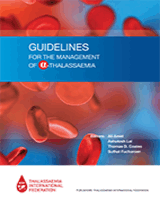From: Chapter 12, CURATIVE THERAPIES FOR α-THALASSAEMIA

Guidelines for the Management of α-Thalassaemia [Internet].
Amid A, Lal A, Coates TD, et al., editors.
Nicosia (Cyprus): Thalassaemia International Federation; 2023.
© Thalassaemia International Federation.
NCBI Bookshelf. A service of the National Library of Medicine, National Institutes of Health.